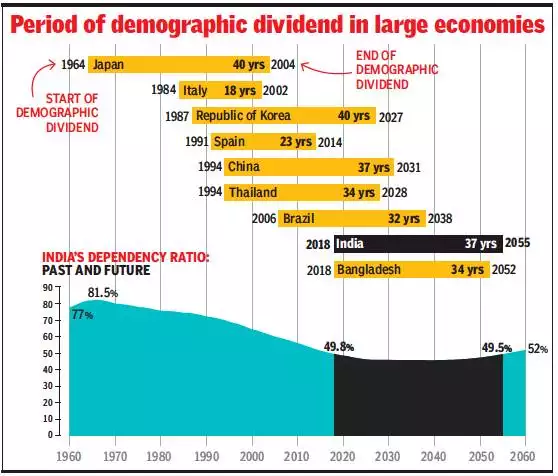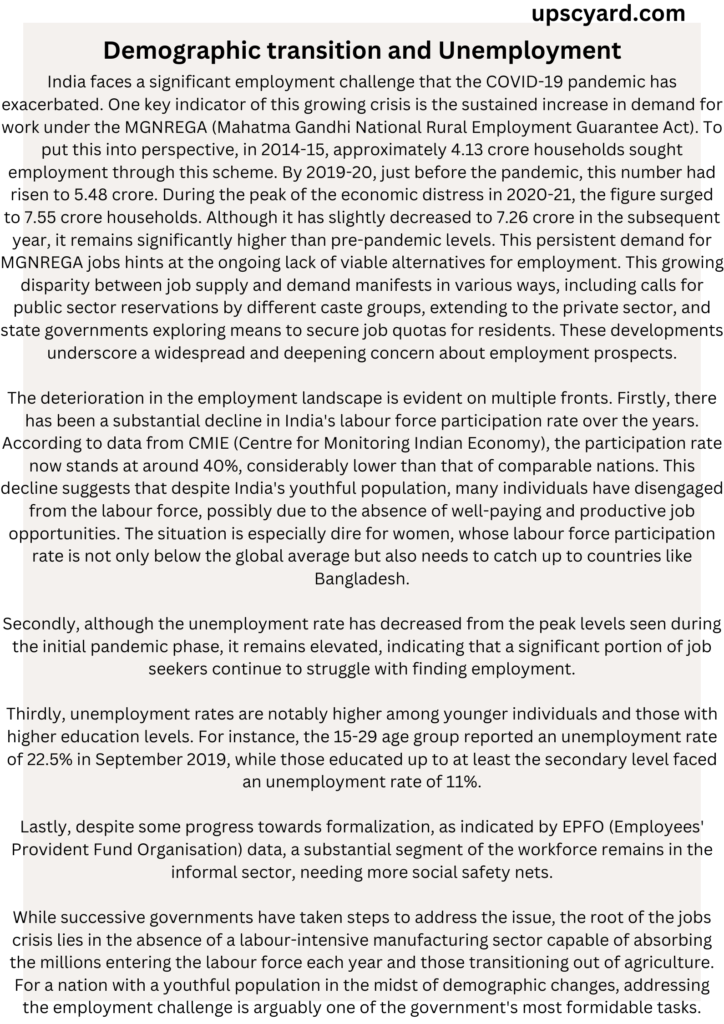
By the definition of the United Nations Population Fund (UNFPA), Demographic dividend refers to the advantageous economic situation that arises from having a favourable demographic composition within a population. This occurs when there is a higher proportion of individuals in the working-age bracket (typically between 15 and 64 years old) in comparison to the dependent population, which includes children and older people. This demographic scenario can lead to several positive outcomes for a country’s economy.

Demographic Dividend in India
A. Challenges
- Inadequate Job Creation: India’s rapidly growing population requires gainful employment opportunities, but the economy needs help to generate an adequate number of jobs to meet this demand. For instance, the Labour Force Participation Rate (LFPR) stood at just 41.6% during the 2020-21 period, as per the Periodic Labour Force Survey.
- Education and Skill Mismatch: The Indian education system often fails to equip young individuals with the necessary skills for the job market. This results in a significant disconnect between the skill sets of the workforce and the specific requirements of employers. As highlighted in a 2018 report by the National Council of Applied Economic Research (NCAER), around 54% of surveyed final-year bachelor’s students aged 18-29 were deemed “unemployable.”
- Health and Nutrition Challenges: A substantial portion of the Indian population faces issues related to malnutrition, poor health, and limited access to essential healthcare services. These factors significantly hamper their ability to participate effectively in the workforce and contribute to economic growth. Alarming statistics, such as India’s ranking of 132 out of 191 countries in the 2021 Human Development Index (HDI), with an HDI value of 0.633, underscore the magnitude of the problem.
B. Latest Findings
Considering the diverse Total Fertility Rates (TFRs) across states in India, the opportunity for harnessing the demographic dividend becomes available at distinct intervals in various regions. This necessitates the implementation of tailored policies rather than a uniform approach for the entire nation.
Recently, a government minister highlighted the potential of India’s demographic dividend as a means to foster self-reliance or Atmanirbhar Bharat.
Despite efforts, Bihar continues to grapple with persistently high poverty rates in contrast to the national averages. Startlingly, as indicated by the 2018 Global Multidimensional Poverty Index, over half of Bihar’s population is categorized as “multidimensionally poor.”

The Path to Harnessing a Demographic Dividend
To unlock the benefits of a demographic dividend, a nation must embark on a transformative journey known as a demographic transition. This transition entails a shift from a state characterized by high rates of both fertility (the number of children born per woman) and mortality (death rates) to one marked by lower fertility and mortality.
This transition typically begins with a reduction in mortality rates, primarily due to advancements in healthcare, improved sanitation, and enhanced disease control measures. As child survival rates increase, more children reach adulthood, contributing to a growing working-age population.
Consequently, this reduction in mortality often triggers a subsequent decline in fertility rates. As families observe higher child survival rates and improved living conditions, they tend to have fewer children. This shift in family planning leads to smaller family sizes and ultimately frees up household resources. These additional resources can then be directed toward long-term investments in areas such as education, healthcare, and economic development.
In essence, the demographic transition represents a critical turning point in a nation’s demographic composition. It paves the way for the demographic dividend by aligning population dynamics with economic opportunities. However, it’s important to note that this transition doesn’t happen overnight; it is a gradual process that unfolds over time. Successful navigation of this transition is essential for any country aspiring to harness the potential economic benefits associated with a demographic dividend.

UPSC Mains Practice Questions
Q. How does the government envision the public sector contributing to harnessing India’s advantageous demographic dividend?
A.
India is currently home to an impressive demographic, with over 600 million individuals falling within the age range of 18 to 35 and approximately 65% of the population being under 35 years old. This demographic dividend is anticipated to extend until at least 2055-56, with its peak projected around 2041 when the working-age population, spanning from 20 to 59 years, is estimated to reach 59%. This represents a substantial opportunity that can be harnessed with the right conditions in place or through deliberate creation.
Under the visionary leadership of Prime Minister Narendra Modi, India has introduced a forward-looking National Education Policy (NEP). Experts have highlighted that more than 80% of a child’s brain development occurs before the age of six. In a historic move, India has now incorporated early childhood care and education into the formal schooling system. Furthermore, our government is committed to promoting multilingualism as an integral part of the NEP.
Prime Minister Modi’s vision extends to making India the global hub for skill development. Substantial progress has been made swiftly and extensively in skilling, reskilling, and upskilling our youth. We have successfully trained over 63.5 million individuals through various initiatives, establishing a robust network of skill institutes. Our efforts also aim to encourage the participation of more women in vocational training, fostering empowerment and inclusivity.
MCQ.
With reference to Right to Education in India, which of the following statements is/are correct ?
A.It guarantees teacher’s accountability for the learning process of children
B.It guarantees 100% enrollment of children in the schools
C.It intends to take full advantage of demographic dividend
India is regarded as a country with ―Demographic Dividend‘‘.
A. Its high population in the age group below 15 years .
B. Its high population in the age group of 15-64 years.
C. Its high population in the group age of above 65 years.
D. Its high total population .
